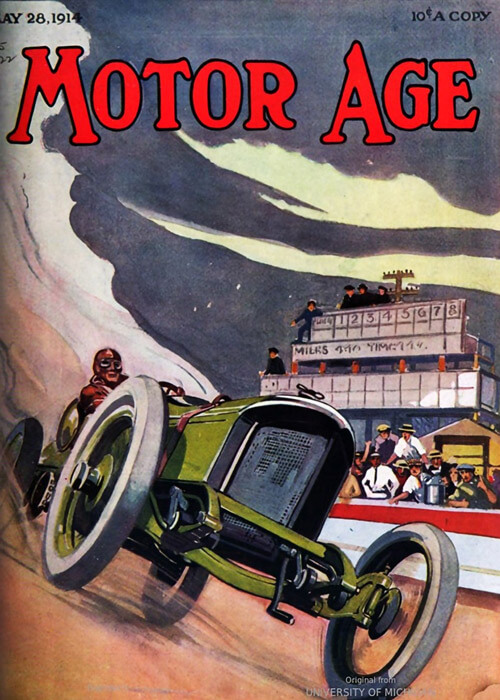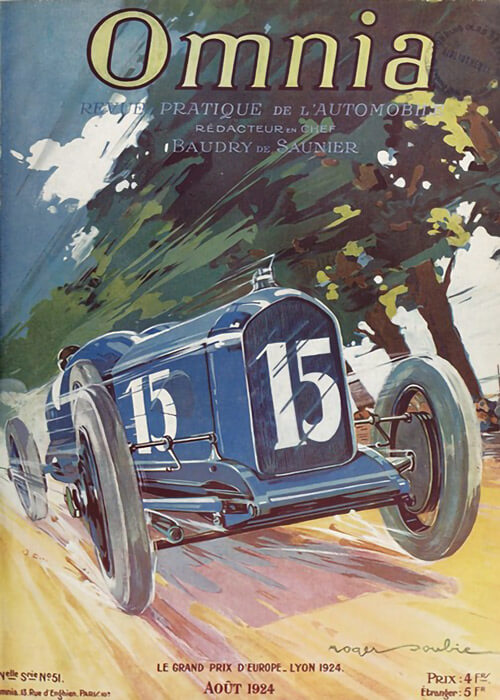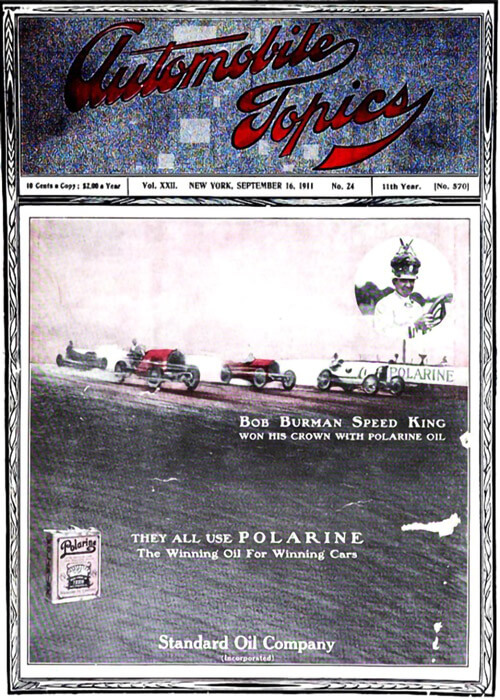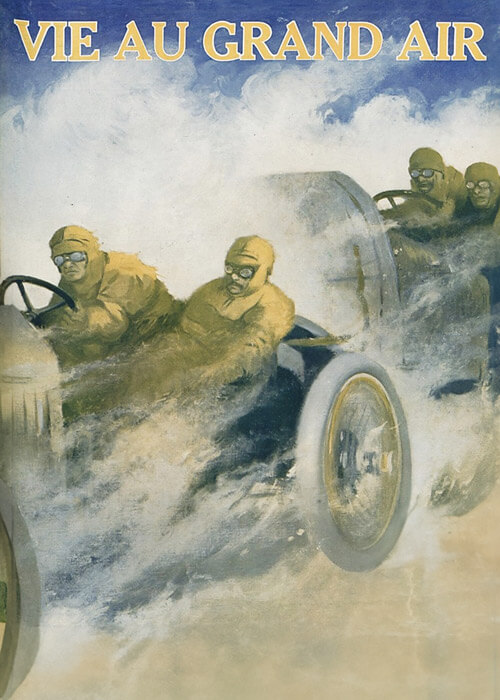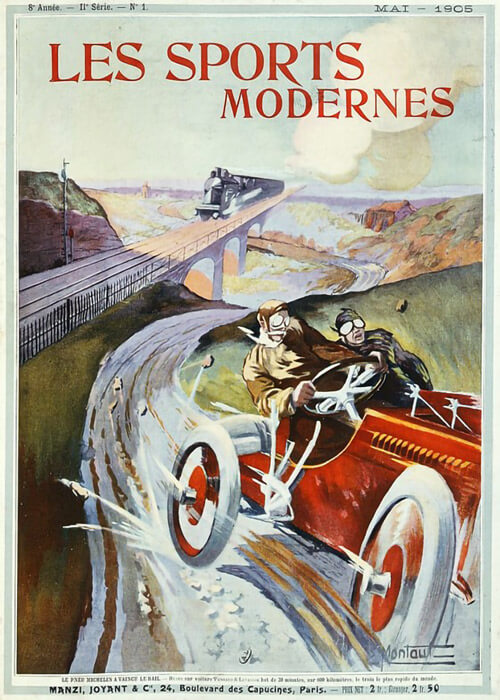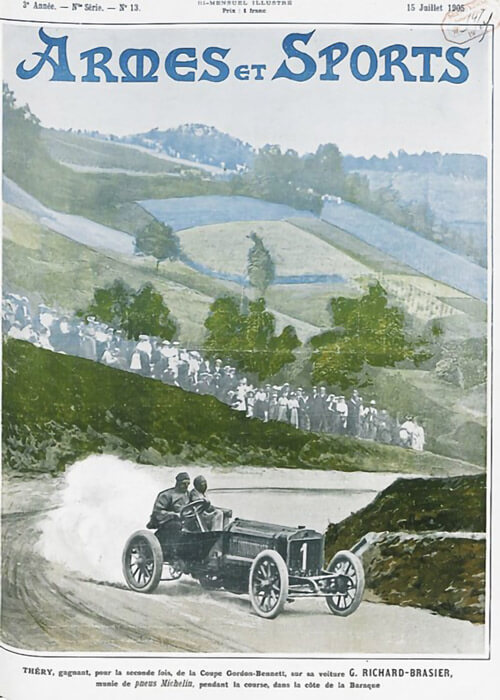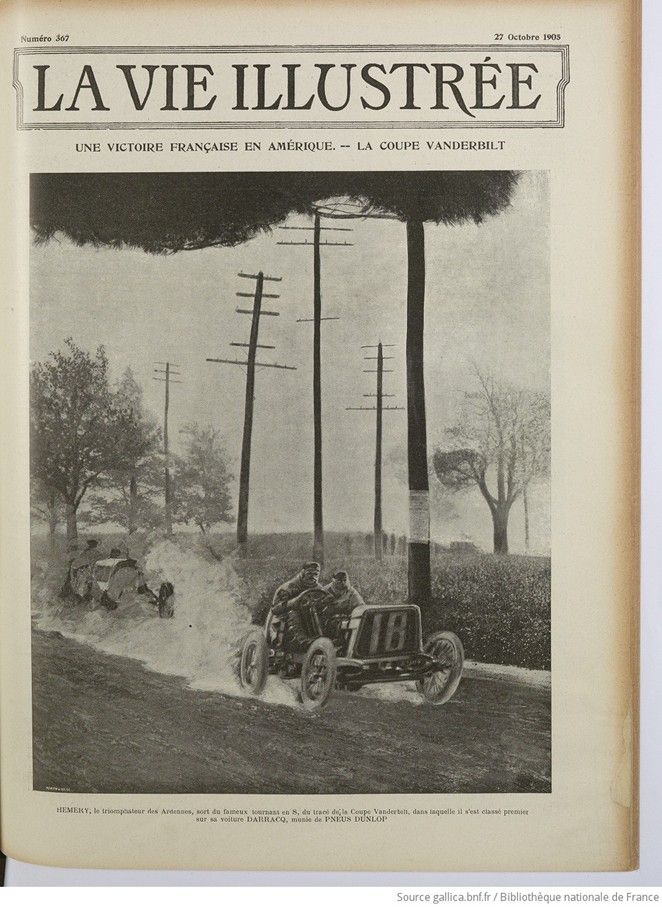


Texte et images jpg compilé par motorracinghistory.com, avec l’autorisation de gallica.bnf.fr / / Bibliothèque national français
LA VIE ILLUSTRÉE – Numéro 367 – 27 Octobre 1905
La Vie Sportive
LA COUPE VANDERBILT – On sait que la Coupe Vanderbilt vient de se terminer par une nouvelle grande victoire de l’industrie française. Nous avons publié la semaine dernière les photographies des deux premiers ; nous leur avons consacré de trop courtes lignes : l’Amérique est loin et le télégraphe trop bref.
Aujourd’hui, nous connaissons tous les détails de cette grande bataille ; nous pouvons tout à loisir en parler de façon détaillée, et en apprécier les conséquences plus exactement.
Ici, en France, et même, pour mieux dire, en Europe, il semblait qu’on n’eût pas accordé à la Coupe Vanderbilt une importance comparable à celle de la Coupe Gordon-Bennett. De l’autre côté de l’Atlantique, au contraire, la Coupe Vanderbilt était tout, la Coupe Gordon-Bennet, elle, apparaissait comme étant de l’histoire ancienne. Les Américains étaient chez eux, ils bluffaient outrageusement. Certains concurrents malheureux de la Coupe Gordon Bennett se laissaient interviewer volontiers ou publiaient des écrits qui se terminaient invariablement par des rodomontades telles, que beaucoup finirent par croire en Amérique que le jour de la Coupe Vanderbilt marquerait la déroute des étrangers.
Un fait bien significatif aurait dû cependant donner aux Américains une plus juste notion de leur valeur. Là-bas, des éliminatoires furent disputées afin de qualifier les cinq meilleures voitures. Deux seulement terminèrent, toutes les autres furent … éliminées. Logiquement, on aurait dû prendre celles qui s’étaient le plus approchées du but. C’est ce qu’on ne fit pas, sous prétexte qu’elles étaient des voitures de tourisme et qu’il fallait, pour disputer une course, avoir des voitures de course. Et, bien que la Coupe se disputât sur un circuit de 45 kilomètres — un vrai looping the loop — à boucler dix fois, la commission décida de qualifier, outre Dingley et Tracy, les deux premiers, Little et White arrêtés au second tour et la voiture Christie, à condition que son fabricant la conduisît lui-même. On verra plus loin quel fut le rôle de ce concurrent dans la course.
Inutile de vous dire que l’annonce de ce verdict causa de violentes protestations parmi les conducteurs évincés, au mépris de leur droit acquis. Non sans raison, ils demandèrent pourquoi on avait institué une éliminatoire, puisqu’il n’était tenu aucun compte des résultats.
A cela, le président de la commission, M. Robert Morrell, répondit : « Nous avons eu en vue de ne pas défendre les intérêts de tel ou tel fabricant américain, mais bien ceux du pays tout entier. En conséquence, nous avons choisi les cinq voitures les plus aptes à lui donner une chance de victoire et de retenir la Coupe Vanderbilt de ce côté de l’Océan… » Singulière prétention, n’est-ce pas, lorsqu’il s’agit de machines incapables de franchir quatre-vingt-dix kilomètres !
Cette digression était utile, pour bien montrer combien l’industrie automobile américaine est en retard et faire comprendre toute la portée qu’avait pour nous une victoire dans la libre Amérique, qui, sous ce rapport, est obligée d’avoir recours à la fabrication européenne.
Et cette victoire, nous l’avons dit, a un retentisse ment d’autant plus considérable, qu’elle marque la supériorité des usines qui exportent chaque année le plus de véhicules. Qui, dans le monde entier, ne connaît de réputation les voitures légères Darracq ? Avec la Darracq, ce n’est pas une marque seule qui triomphe, c’est la fabrication française tout entière, car M. Darracq a de hautes idées ; il s’est fait le champion de notre belle industrie.
Lorsqu’il fut décidé, avant la Coupe Gordon-Bennett, que la France ne prendrait plus part à aucune épreuve de ce genre. M. Darracq s’est dressé pour dire énergiquement : « Et qui donc, s’il vous plaît, m’empêchera de faire courir toujours et partout, tant qu’il me plaira ! »
Ce rude homme pouvait ainsi parler.
Il pensait en effet : « Je veux faire courir, malgré tout. »
Si inégaux que soient les combats que nous livrerons, notre fabrication est si supérieure à toutes les autres que nous vaincrons envers et contre tous. »
En voulant atteindre ce but difficile, M. Darracq, en véritable lutteur qu’il est, malgré le travail considérable qu’il produit sans discontinuer, a redoublé d’activité. Il a su satisfaire à la fois sa clientèle, produire des milliers de voitures et triompher partout cette année avec une telle continuité, qu’il n’est pas une marque au monde qui puisse s’enorgueillir de la moitié de ses succès. Tel, le soleil donnant la vie à la terre, la renommée des Darracq a donné une vigueur nouvelle à toute notre industrie en la prenant sous sa protection.
Honneur soit rendu à M. Darracq !
Il est aussi nécessaire de rendre hommage à un nouveau venu à la course, au pneumatique Dunlop. Sans aller jusqu’à prétendre, comme certains l’ont fait avec exagération, que nos courses se réduisaient à l’heure actuelle à un match entre les différents pneumatiques, il faut reconnaitre, en toute logique, qu’à une bonne voiture, il faut un bon pneumatique. Le Dunlop peut sans crainte se reconnaître cette qualité, puisque Hémery n’a pas eu un seul arrêt imputable à ses bandages, malgré son allure moyenne de 100 kilomètres à l’heure.
Ayant dit plus haut que le Dunlop était nouveau venu à la course, nous devons rappeler qu’il est cependant le doyen des pneumatiques. Voilà, ce me semble, une verte vieillesse !
Notre excellent confrère Les Sports faisait remarquer dernièrement quelles embûches Hémery avait trouvées sur sa route avant de triompher:
« Hémery, dit-il, peut se flatter de revenir de loin pour cette victoire, non seulement dans la course elle-même, mais même pour y prendre part. On se souvient, en effet, que les Eliminatoires françaises de la Coupe Bennett devaient également désigner les tenants de la France dans la Coupe Vanderbilt. »
Or, dans les éliminatoires, Hémery avait été particulièrement guignard, et il avait fini neuvième, alors que les cinq premiers seuls étaient qualifiés. Mais la maison Richard-Brasier retira d’abord Théry et Caillois, et du coup Hémery passa septième. Sur ces entrefaites, la maison Gobron-Brillé ayant vendu la voiture de Rigolly, se retira aussi, Hémery passa sixième, mais la maison Hotchkiss retira également la voiture de Le Blon, et Hémery arriva ainsi cinquième.
Les avatars ne s’arrêtèrent pas là. On sait qu’au Circuit de Brescia, Hémery eut une algarade avec les chronométreurs. Une plainte fut déposée à l’A. C. d’Italie et Hémery fut suspendu pendant un an. Il lui était donc impossible de courir la Coupe Vanderbilt. Mais l’A. C. d’Italie ne transmit la demande d’application de la peine à l’A. C. F. qu’au moment où Hémery était embarqué déjà avec sa voiture pour l’Amérique et où il devenait par conséquent difficile, sinon impossible, à M. Darracq de le remplacer. Avec une grande largeur d’esprit, la Commission sportive de l’A. C. F. décida d’attendre après la Coupe pour appliquer la peine à Hémery.
Le malheureux pouvait se croire tiré d’affaire. Il n’en était rien.
Une question de pneumatiques faillit l’empêcher encore de courir. M. Darracq alla jusqu’à télégraphier de ne pas faire partir ses voitures. Il y eut, au dernier moment, un départ général, par le dernier transatlantique, avec de nouveaux pneus. Enfin tout fut embarqué… Hémery allait courir. Pas encore, car la veille de la course M. Darracq recevait du baron de Turckheim, représentant l’A. C. F., une dépêche l’informant que les pneus d’Hémery étaient restés en douane et qu’il était impossible de les dédouaner. M. Rawlinson, l’agent des Darracq en Angleterre, et M. Stevens, remuèrent ciel et terre et Hémery put arriver à temps au pesage.
On respire. Pas encore. On a si peu mécanisé la voiture dans tout ce tra-la-la qu’on a détérioré un cylindre. Hémery répare, il a juste le temps pour le pesage. Il arrive enfin au poteau. Il part, et il gagne.
Avouez qu’il ne l’avait pas volé.
L’éclat de la victoire d’Hémery ne doit pas nous empêcher d’associer à son succès, Heath monté sur pneus Michelin. Heath, en terminant à trois minutes et quelques secondes d’Hémery, s’est associé au succès de celui-ci, soulignant ainsi la supériorité de l’automobilisme français. En se classant second, Heath, vainqueur de cette même coupe en 1904, triomphe donc une seconde fois, et avec lui les pneus Michelin, qui n’en sont plus à compter leurs succès.
La surprise la plus grande que la coupe ait causée est bien la place de troisième échue à l’Américain Tracy. Comment l’expliquer ? Voici : La locomobile de Tracy a terminé à 23 minutes de la Darracq d’Hémery. C’est déjà un fort joli résultat. Il nous prouve qu’on a tout au moins construit une bonne voiture en Amérique, sans qu’elle soit un phénomène cependant. Quatre concurrents ont seuls terminé la course. Tracy se serait classé quatrième si… cette place n’avait été prise par Lancia, aurait dit M. de La Palisse.
J’entends bien la plaisanterie, mais il n’est pas per mis cette fois de l’appliquer au malheureux Lancia qui dut s’arrêter plus d’une heure au huitième tour.
La trop fameuse Christie, qui faisait un tour pendant que les premiers en accomplissaient trois, réussit à tamponner la voiture de Lancia, au moment où celui-ci était arrêté à un contrôle. Ce fut son plus bel exploit.
Le pauvre Lancia répara courageusement et termina comme il put. Il eut une crise de désespoir fort compréhensible d’ailleurs, à la fin de la course, puisque, avant son accident, il avait roulé à une moyenne de 112 kilomètres à l’heure, sans avoir eu un seul ennui.
La voiture de Lancia était munie de pneus Michelin.
Déjà, lors des essais préliminaires, tous les concurrents se plaignirent en haut lieu des conducteurs américains, auxquels des observations furent adressées. Lancia s’était lui-même livré à un assaut de boxe avec White. Quant à la voiture Christie, à quatre roues motrices, — excusez du peu, — elle avait eu deux accidents lors des éliminatoires américaines. En la qualifiant d’office on en a causé un troisième. Cette triste farce n’aura servi qu’à blesser grièvement son conducteur.
Maintenant, une question se pose. Que va devenir la Coupe Vanderbilt ? L’A. C. F., fidèle à sa parole, a décidé que c’était la dernière fois que la France y prendrait part.
Attendons la solution, mais félicitons-nous de pouvoir applaudir, après ce dernier acte, au triomphe de notre industrie. Victor Lefèvre.
Photos, LA VIE ILLUSTRÉE
Page 44: La Coupe Vanderbilt. — HEATH, deuxième, sur voiture française, munie de pneus Michelin, prend le tournant de Bull’s Head.
JOE TRACY, TROISIÈME, SUR VOITURE AMÉRICAINE, SORT DU TOURNANT DU. BOIS DE GUENEE
Page 45: JOE TRACY, TROISIÈME, SUR VOITURE AMÉRICAINE, PHOTOGRAPHIÉ A L’ARRIVÉE
JOE TRACY, TROISIÈME, SUR VOITURE AMÉRICAINE, SORT DU TOURNANT DU. BOIS DE GUENEE
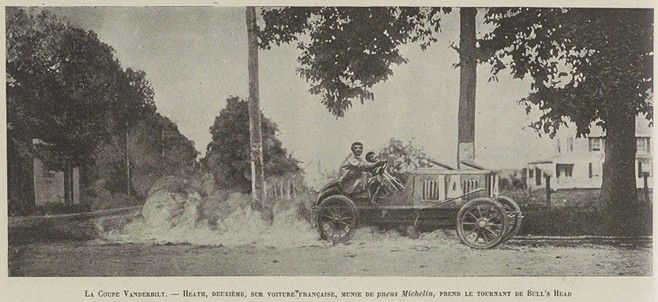
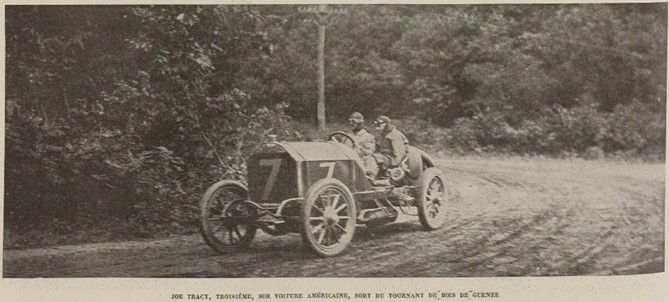




Translation by motorracinghistory.com, supported by DeepL.com
THE VANDERBILT CUP. – We know that the Vanderbilt Cup has just ended with another great victory for French industry. Last week we published photographs of the first two; we devoted too few lines to them: America is far away and the telegraph is too brief.
Today, we know all the details of this great battle; we can talk about it in detail at our leisure, and assess the consequences more accurately.
Here in France, or even, to be more precise, in Europe, it seemed that the Vanderbilt Cup had not been accorded a level of importance comparable to that of the Gordon Bennett Cup. On the other side of the Atlantic, on the contrary, the Vanderbilt Cup was everything, while the Gordon Bennett Cup seemed to be ancient history. The Americans were at home, and they were bluffing outrageously. Some of the unfortunate competitors in the Gordon Bennett Cup were happy to be interviewed or published writings that invariably ended in such ranting that many in America ended up believing that the Vanderbilt Cup would mark the defeat of the foreigners.
However, one significant fact should have given the Americans a fairer idea of their worth. Over there, qualifying rounds were held to select the five best cars. Only two finished, all the others were … eliminated. Logically, the ones that had come closest to the goal should have been selected. This was not done, on the pretext that they were touring cars and that racing cars were needed to compete in a race. And, although the Cup was contested on a 45-kilometer circuit—a real loop the loop—to be completed ten times, the commission decided to qualify, in addition to Dingley and Tracy, the first two, Little and White, who were stopped in the second round, and the Christie car, provided that its manufacturer drove it himself. We will see later what role this competitor played in the race.
Needless to say, the announcement of this verdict caused violent protests among the drivers who had been ousted, in defiance of their acquired rights. Not without reason, they asked why a preliminary round had been instituted, since no account was taken of the results.
To this, the chairman of the committee, Mr. Robert Morrell, replied: “We had in mind not to defend the interests of this or that American manufacturer, but those of the entire country. Consequently, we chose the five cars most likely to give it a chance of victory and to retain the Vanderbilt Cup on this side of the Ocean…” A strange claim, isn’t it, when we’re talking about machines that can’t even travel ninety kilometers!
This digression was useful, to show how far behind the American automotive industry is and to make clear the significance for us of a victory in free America, which, in this respect, is forced to rely on European manufacturing.
And this victory, as we have said, has all the more considerable resonance, as it marks the superiority of the factories that export the most vehicles each year. Who, throughout the world, is not familiar with the reputation of Darracq light cars? With Darracq, it is not just one brand that triumphs, it is French manufacturing as a whole, because Mr. Darracq has high aspirations; he has become the champion of our fine industry.
When it was decided, before the Gordon Bennett Cup, that France would no longer take part in any event of this kind, Mr. Darracq stood up and said energetically: “And who, may I ask, will prevent me from racing always and everywhere, for as long as I like!”
This tough man could speak like that.
He thought: “I want to run, in spite of everything.“
However uneven the battles we face, our product is so superior to all the others that we will triumph against all odds.
“ In pursuit of this difficult goal, Mr. Darracq, a true fighter, has redoubled his efforts, despite the considerable work he produces without interruption. He has been able to satisfy his clientele, produce thousands of cars and triumph everywhere this year with such continuity that there is no other brand in the world that can boast half of his successes. Just as the sun gives life to the earth, the fame of the Darracqs has given new vigor to our entire industry by taking it under its protection.
All honor to Mr. Darracq!
It is also necessary to pay tribute to a newcomer to the race, the Dunlop tire. Without going so far as to claim, as some have done with exaggeration, that our races are now reduced to a match between the different tires, it must be recognized, logically, that a good car needs a good tire. The Dunlop can safely claim this quality for itself, since Hémery did not have a single stop attributable to his tires, despite his average speed of 100 kilometers per hour.
Having said above that the Dunlop was a newcomer to the race, we must remember that it is, however, the oldest tire. There you have it, a green old age!
Our excellent colleague Les Sports recently pointed out the obstacles Hémery had encountered on his way to triumph:
“Hémery,” he said, ”can be proud of having come a long way to achieve this victory, not only in the race itself, but even to take part in it. We remember, in fact, that the French Eliminatoires of the Bennett Cup also had to designate France’s holders in the Vanderbilt Cup.”
In the qualifiers, Hémery had been particularly lucky, and he finished ninth, while only the first five qualified. But the Richard-Brasier company first withdrew Théry and Caillois, and as a result Hémery moved up to seventh. In the meantime, the Gobron-Brillé company, having sold Rigolly’s car, also withdrew, Hémery moved up to sixth, but the Hotchkiss company also withdrew Le Blon’s car, and Hémery thus finished fifth.
The avatars did not end there. We know that at the Brescia Circuit, Hémery had an altercation with the timekeepers. A complaint was lodged with the A.C. of Italy and Hémery was suspended for a year. It was therefore impossible for him to race in the Vanderbilt Cup. But the A.C. of Italy did not forward the request for application of the penalty to the A. C. F. until Hémery had already boarded his car for America, making it difficult, if not impossible, for Mr. Darracq to replace him. With great open-mindedness, the A. C. F. Sports Commission decided to wait until after the Cup to apply the penalty to Hémery.
The unfortunate man could think he was off the hook. But he was not.
A tire issue almost prevented him from racing again. Mr. Darracq even went so far as to telegraph his cars not to start. At the last moment, they all set off, on the last transatlantic, with new tires. Finally, everything was loaded on board… Hémery was going to race. Not yet, because the day before the race Mr. Darracq received a dispatch from the Baron de Turckheim, representing the A.C.F., informing him that Hémery’s tires had been held in customs and that it was impossible to release them. Mr. Rawlinson, the Darracq agent in England, and Mr. Stevens, moved heaven and earth and Hémery was able to arrive in time for the weighing.
We breathe. Not yet. We have mechanized the car so little in all this tra-la-la that we have damaged a cylinder. Hémery repairs it, just in time for the weigh-in. He finally makes it to the post. He sets off, and he wins.
Admit that he didn’t steal it.
The brilliance of Hémery’s victory should not prevent us from associating his success with Heath, who was driving on Michelin tires. Heath, finishing three minutes and a few seconds behind Hémery, contributed to his success, thus underlining the superiority of French motoring. By finishing second, Heath, winner of this same cup in 1904, triumphed a second time, and with him Michelin tires, which are no strangers to success.
The biggest surprise that the cup caused is the third place won by the American Tracy. How can this be explained? Here it is: Tracy’s locomobile finished 23 minutes behind Hémery’s Darracq. That is already a very good result. It proves to us that at least one good car has been built in America, without it being a phenomenon, however. Only four competitors finished the race. Tracy would have come fourth if… that place hadn’t been taken by Lancia, as M. de La Palisse would have said.
I hear the joke, but this time it can’t be applied to the unfortunate Lancia, which had to stop for over an hour on the eighth lap.
The infamous Christie, who was doing one lap while the leaders were doing three, managed to bump into the Lancia car just as it was stopped at a checkpoint. It was his finest feat.
Poor Lancia repaired courageously and finished as best he could. He had an understandable fit of despair at the end of the race, since, before his accident, he had been driving at an average of 112 kilometers per hour, without having had a single problem.
Lancia’s car was fitted with Michelin tires.
Already, during the preliminary trials, all the competitors complained to the higher authorities about the American drivers, and comments were addressed to them. Lancia himself had engaged in a boxing match with White. As for the Christie car, with four-wheel drive, no less, it had had two accidents during the American qualifiers. By automatically qualifying it, a third accident was caused. This sad farce only served to seriously injure its driver.
Now a question arises. What will become of the Vanderbilt Cup? The A. C. F., true to its word, has decided that this is the last time that France will take part.
Let us await the solution, but let us congratulate ourselves on being able to applaud, after this last act, the triumph of our industry. Victor Lefèvre.
